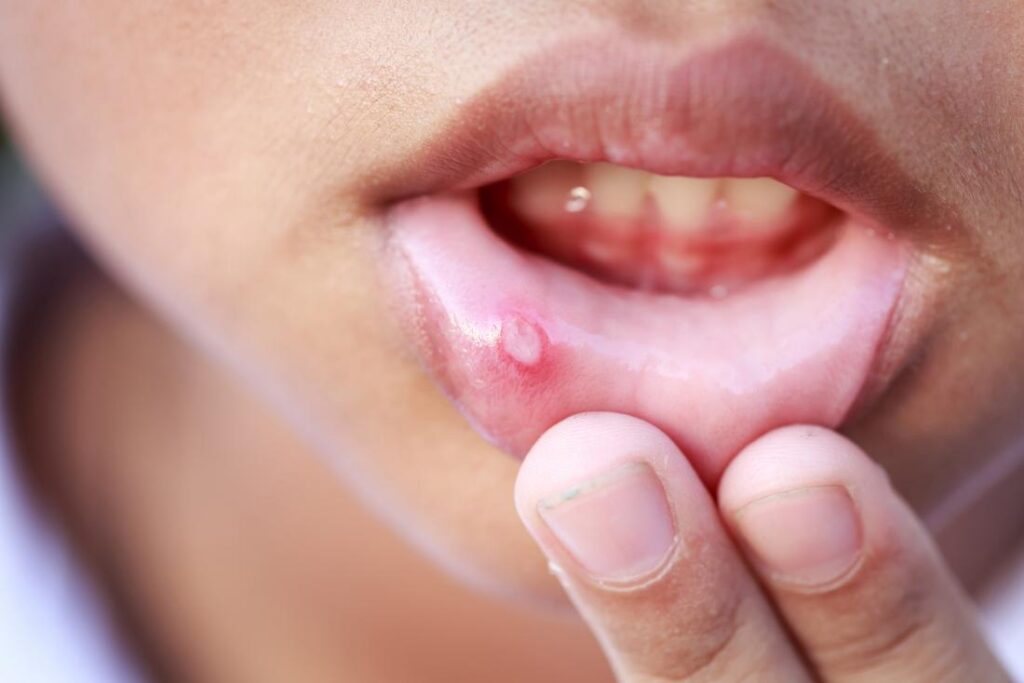Behçet’s disease is a rare, chronic, multisystemic inflammatory disorder characterized by recurrent oral ulcers, genital lesions, ocular inflammation, and systemic involvement. One of the earliest and most consistent features of Behçet’s disease is the presence of recurrent oral aphthous ulcers, which often serve as the initial clinical manifestation.
These ulcers are not merely superficial irritations but are indicative of an underlying autoimmune vasculitis process affecting small and large vessels throughout the body. Proper recognition and differentiation from common aphthous stomatitis are essential for timely diagnosis and systemic management.

Pathogenesis of Oral Ulcers in Behçet’s Disease
The pathogenesis of Behçet’s-related oral ulcers involves a complex interplay of genetic predisposition, immune dysregulation, and inflammatory vascular damage.
The immune system mistakenly targets mucosal tissue, leading to neutrophilic infiltration, endothelial cell damage, and painful ulceration of the oral cavity.
Clinical Features of Oral Ulcers in Behçet’s Disease
Morphology and Presentation
- Type: Minor, major, or herpetiform aphthous ulcers
- Appearance: Round or oval, shallow ulcers with a yellowish base and erythematous halo
- Size: Typically 2–10 mm in diameter
- Number: Single or multiple
- Pain: Significant, often interfering with speaking and eating
- Healing Time: 7–21 days, with or without scarring depending on severity
Location
- Buccal mucosa
- Lips (inner surface)
- Tongue
- Soft palate
- Gingiva
These lesions recur frequently, sometimes at intervals of only a few weeks, mimicking common aphthous ulcers, but with more systemic implications.
Differentiating Behçet’s Oral Ulcers from Aphthous Stomatitis
| Feature | Behçet’s Disease | Recurrent Aphthous Stomatitis |
|---|---|---|
| Systemic Involvement | Yes (eyes, skin, genitalia, joints) | No |
| Ulcer Size | Often larger and deeper | Usually small |
| Ulcer Frequency | More frequent and severe | Less frequent |
| Scarring | May be present after healing | Rare |
| Associated Symptoms | Fever, joint pain, genital ulcers | None |
Timely distinction is critical, as early treatment can prevent severe systemic complications.
Diagnostic Approach to Behçet’s Disease with Oral Ulcers
There is no single definitive test for Behçet’s disease. Diagnosis is primarily clinical and based on internationally recognized criteria.
International Criteria for Behçet’s Disease (ICBD)
To meet the diagnostic threshold:
- Oral ulcers (mandatory): Recurrent (≥3 episodes/year)
- Plus at least two of the following:
- Genital ulcers
- Eye lesions (uveitis, retinal vasculitis)
- Skin lesions (erythema nodosum, papulopustular lesions)
- Positive pathergy test
- Vascular or neurological involvement
Supporting Investigations
- Blood tests: Elevated ESR, CRP, leukocytosis
- Pathergy test: Skin hyperreactivity (not universally positive)
- Biopsy: Non-specific vasculitis or neutrophilic infiltration
Systemic Implications of Oral Ulcers in Behçet’s Disease
Oral ulcers are not isolated events in Behçet’s disease but serve as indicators of broader systemic inflammation. Associated complications include:
- Genital ulcers
- Ocular inflammation (anterior/posterior uveitis)
- Skin lesions (pseudofolliculitis, acneiform eruptions)
- Neurological manifestations (meningoencephalitis)
- Vascular complications (deep vein thrombosis, arterial aneurysms)
- Joint involvement (arthralgia or arthritis)
Thus, persistent or severe oral ulcers should prompt thorough systemic evaluation.
Treatment of Oral Ulcers in Behçet’s Disease
Local Therapy
- Topical corticosteroids (triamcinolone acetonide, clobetasol)
- Antiseptic mouth rinses (chlorhexidine)
- Topical anesthetics (lidocaine gel) for pain relief
Systemic Therapy
- Colchicine: First-line agent for mucocutaneous lesions
- Corticosteroids: Systemic steroids for severe or refractory ulcers
- Immunosuppressants: Azathioprine, cyclosporine, methotrexate
- TNF-alpha inhibitors: Infliximab, adalimumab for resistant or severe systemic disease
- Thalidomide: In select cases, for chronic oral/genital ulcers
Therapy is tailored based on the severity of mucosal lesions and the presence of systemic involvement.
Lifestyle and Supportive Measures
- Avoid triggering foods (spicy, acidic)
- Maintain oral hygiene with soft-bristle brushes
- Smoking cessation
- Psychological support (stress management)
- Regular follow-ups for systemic screening and treatment adjustment
Prognosis and Disease Monitoring
The prognosis of Behçet’s disease varies. In many cases, oral ulcers persist for years, waxing and waning in frequency and severity. Although mucocutaneous symptoms may dominate the early course, vigilant surveillance for ocular, neurological, and vascular complications is essential.
Monitoring Tools:
- Behçet’s Disease Current Activity Form (BDCAF)
- Visual analog scales for pain
- Regular ophthalmic and rheumatologic evaluations
Frequently Asked Questions
Are oral ulcers in Behçet’s disease contagious?
No, these ulcers are not infectious or contagious; they result from autoimmune inflammation.
Can Behçet’s oral ulcers be the only symptom?
Yes, especially in the early stages. However, systemic symptoms often appear later, warranting close observation.
How are Behçet’s oral ulcers different from canker sores?
Behçet’s ulcers are typically larger, deeper, more painful, and associated with systemic signs like genital ulcers and eye inflammation.
Is there a permanent cure for oral ulcers in Behçet’s disease?
Currently, there is no cure. Treatment focuses on symptom control and prevention of systemic flares.
How often should patients with oral ulcers be monitored?
Patients should have regular follow-ups every 3–6 months or sooner if new symptoms emerge.
Oral ulcers associated with Behçet’s disease are not merely mucosal lesions but a cardinal sign of a potentially disabling systemic vasculitis. Accurate diagnosis, thorough differentiation from benign aphthous ulcers, and prompt, multidisciplinary management are key to improving outcomes. With a tailored treatment approach and regular monitoring, patients can achieve meaningful symptom relief and a better quality of life.